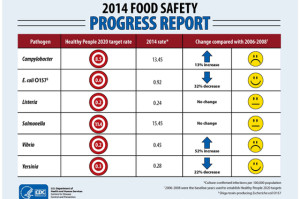The U.S. Centers for Disease Control and Prevention Foodborne Diseases Active Surveillance Network, or FoodNet, has been tracking trends for infections transmitted commonly through food since 1996.
 FoodNet provides a foundation for food safety policy and prevention efforts. It estimates the number of foodborne illnesses, monitors trends in incidence of specific foodborne illnesses over time, attributes illnesses to specific foods and settings, and disseminates this information.
FoodNet provides a foundation for food safety policy and prevention efforts. It estimates the number of foodborne illnesses, monitors trends in incidence of specific foodborne illnesses over time, attributes illnesses to specific foods and settings, and disseminates this information.
“FoodNet has matured and transformed over 20 years, and continues to evolve as technologies change,” says Dr. Olga Henao, FoodNet Team Lead.
The Foodborne Diseases Active Surveillance Network, or FoodNet, has been tracking trends in foodborne infections since 1996.
FoodNet provides a foundation for food safety policy and prevention efforts by estimating the number of foodborne illnesses, monitoring trends of specific foodborne illnesses, conducting studies to understand the causes of these illnesses, and informing the public about its findings.
FoodNet began to collect information on two pathogen cases identified by CIDT in 2009 and expanded the collection to other pathogens in 2011.
FoodNet has conducted surveillance for laboratory-confirmed cases of infection in humans caused by Campylobacter, Listeria, Salmonella, Shiga toxin-producing E. coli (STEC) O157, Shigella, Vibrio, and Yersinia since 1996, Cryptosporidium and Cyclospora since 1997, and STEC non-O157 since 2000. FoodNet staff in state health departments contact clinical laboratories in the surveillance area to get reports of infections diagnosed in residents.
Special Studies
Although foodborne outbreaks are common, most foodborne infections are sporadic, meaning they are not related to an outbreak. We can only rarely determine how one person got an infection but, by studying a large number of people with the same type of infection, we can often determine risk factors for getting ill.
Major Contributions
FoodNet is the only U.S. system focused on obtaining comprehensive information about sporadic infections caused by pathogens transmitted commonly through food. The network’s contributions to food safety policy and illness prevention include:
Establishing reliable, active population-based surveillance to understand who gets sick and why;
Developing and implementing studies that determine risk and protective factors for foodborne infections;
Conducting population surveys and laboratory surveys that describe the features of gastrointestinal illnesses, medical care-seeking behavior, foods eaten, and laboratory practices; and
Improving our ability at the federal and state level to track and study foodborne illnesses and respond to new issues as they arise.
About FoodNet
Surveillance in an area that includes 15% of the U.S. population (approximately 48 million people)
Collaboration among CDC, 10 state health departments, the U.S. Department of Agriculture’s Food Safety and Inspection Service, and the Food and Drug Administration. (Image: U.S. map showing FoodNet sites.)
Principal foodborne disease component of CDC’s Emerging Infections Program
Provides the data necessary for measuring the progress in foodborne disease prevention.
